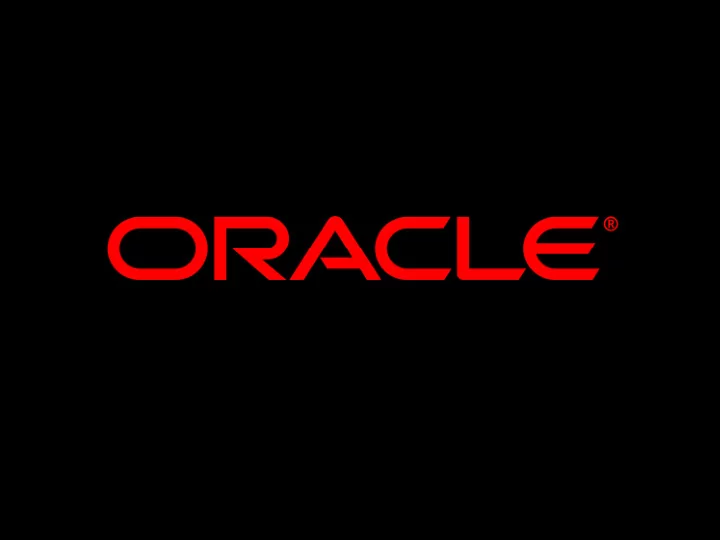

A Business Rules Perspective on a Standard Rules Language Gary Hallmark April 28, 2005
Outline � Benefits of business rules � Rule enabled business application lifecycle � Benefits of standardization � Business rule requirements by example � Conclusion: standardize current practice
Benefits of Business Rules Greater agility, better decisions, lower cost � capture important and changing business policies � store in a repository separate from application code � business analysts, not programmers, modify rules in response to – changing regulations – competitive pressure – customer demand
Rule Enabled Business Application Lifecycle Business logic 1. Programmers and 4. Programmers and Business Business Analysts Analysts test system Rules separate Business Rules from other 5. Production Other logic logic deployment 2. Programmers class person { 6. Future Rules provide Facts and int age; changes made int salary; Actions to Rule int retireSalary directly by Analysts boolean Authoring Tool rapidly and cheaply disabled; } 3. Analysts define Rules facts Rules Rules repository Engine results Rule Authoring Tool application
Benefits of Standardization � Lower cost and risk � Increase market for business rules � Improve quality through specialization Natural language and graphical rule authoring tools – Rule engines for different environments—J2EE, .NET, database) – Rule content— e.g. yearly tax law compliance, Sarbanes-Oxley – requires standard fact types (ontology), too � Benefit to Oracle of standard rules and standard middleware Acquired applications (Peoplesoft, JD Edwards, Retek, etc. ) built – on standards are easier for Oracle to integrate in a suite Best of breed applications built on standards are easier for – customers to integrate
Business Rule Requirements � Support Natural Language and Decision Table interfaces � Hide complexity of facts � Invoke application methods and define functions � Execute arbitrary actions � Control order of rule firing � Support forward and backward chaining
User Interface W3C must standardize underlying XML syntax and semantics � Structured Natural Language Business Analysts are not programmers or logicians age of driver is less than 30 not driver[@age < 30] op:lt(age(?driver), 30) nor � Decision Tables age greater than age not greater than vehicle type risk 15 25 - high 25 30 sports high 30 70 sedan low Easy to spot gaps and overlaps
Hide Complexity of Facts � Simple facts => simple rules, e.g. if age of driver is … � Business analysts should see A business term, e.g. “driver” – Documentation, e.g. “anyone in the household of driving age” – A set of named properties, e.g. “name”, “age”, “vehicle” – A set of methods, e.g. “vehicle usage percent” – � Programmers see more detail Data source: XML document, database, Java class, RDF, … – Mapping info, e.g. “driver” maps to – http://xmlns.oracle.com/rules/rate-quote.xsd:driver-info � A programmer provides a library of fact definitions to the business analyst for use in rules
Invoke Application Methods and Define Functions � Must be able to invoke methods on underlying application objects, even in rule conditions if vehicle usage percent of driver is greater than 0.5 then … � Must be able to define functions with rich set of operators in the rule language if business analysts are to maintain them function vehicle usage percent of driver is 10000 / (miles per day of driver * 365)
Execute Arbitrary Actions � Modify the knowledge base to support inference if a customer spent $500 last month – then set his status to GOLD if a customer's status is GOLD – then discount his shipping by 50% � Append to a log of rule firings to explain decision � Invoke a credit report web service to retrieve new facts � Update a database � Rules that can only describe actions require application code (an interpreter) to execute the descriptions ties rule maintenance to application program maintenance –
Control Order of Rule Firing � Declarative is good Rules can be optimized ( e.g. Rete, Magic Sets) – Rules can be maintained without intimate knowledge of – neighboring rules � Declarative is not good enough Not all rules apply equally all the time – Add state facts and extra rule conditions—cumbersome – Selectively load rule sets from rule repository – Rule priority ( aka salience) – prone to abuse – Rule set focus, rule flow –
Support Forward and Backward Chaining � Forward chaining production rules satisfy most requirements with good performance � Rete is efficient, proven, and mature technology � Backward chaining is useful to fetch expensive facts on demand, e.g. if job status of applicant equals “unemployed” or reportee of credit report equals applicant and score of credit report is less than threshold then deny the loan job status is cheap to check – credit report must be purchased and fetched from a web service – rule should fetch the credit history only if the applicant is employed –
Conclusion A standard rule language should support the features of mainstream business rules engines � Market leaders (iLog, Blaze) are on the right track � Focus on UI, repository, testing, and coverage tools � Lower cost and risk to increase the number of users
Q U E S T I O N S Q U E S T I O N S A N S W E R S A N S W E R S
Recommend
More recommend